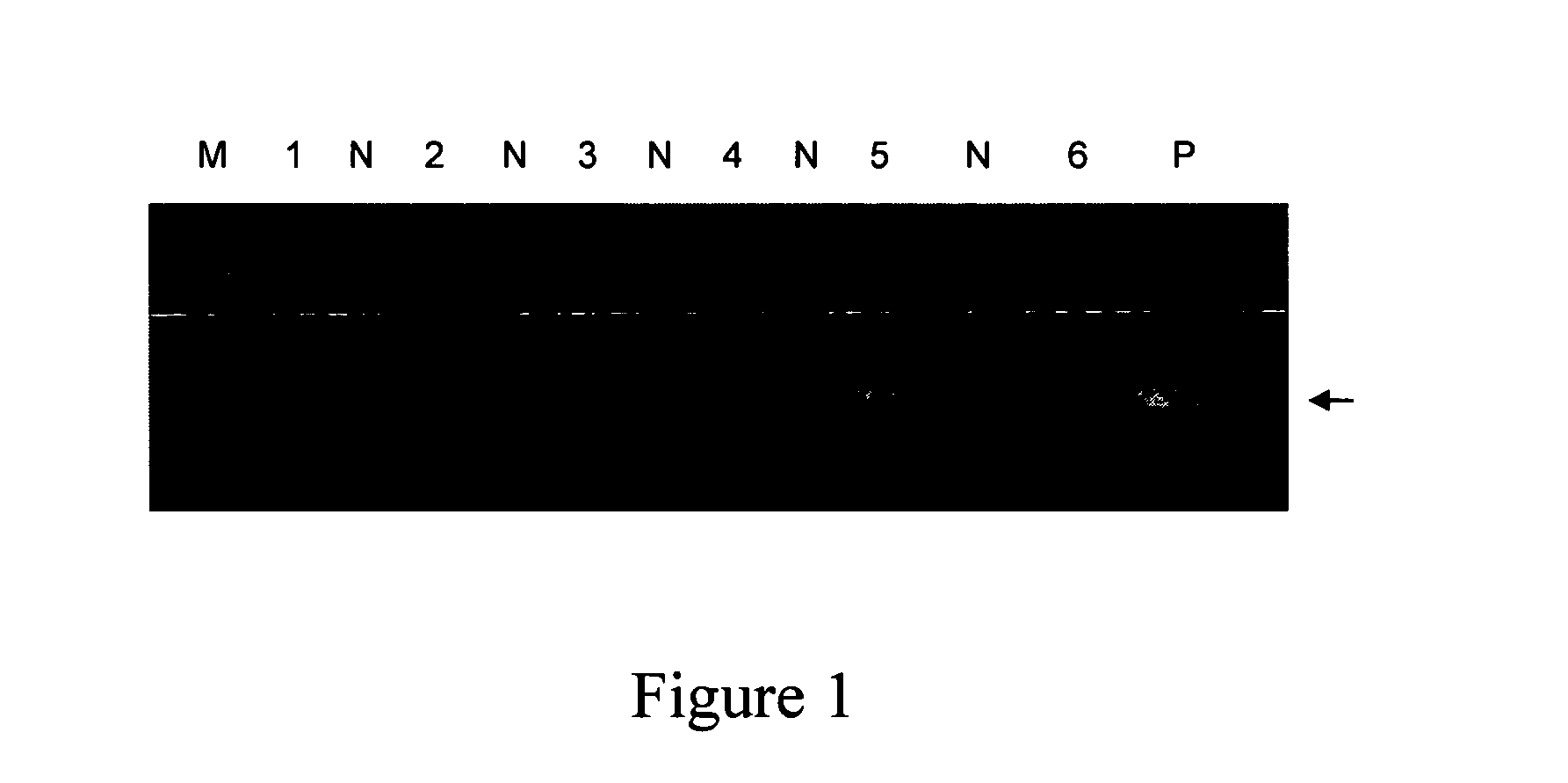Helicobacter pylori antigens in blood
a technology of helicobacter pylori and antigens, which is applied in the field of methods for detecting helicobacter pylori (h . pylori) dna in blood, can solve the problems of high bacteria density, inconvenient diagnosis of h. pylori infection, and insufficient invasive tests
- Summary
- Abstract
- Description
- Claims
- Application Information
AI Technical Summary
Benefits of technology
Problems solved by technology
Method used
Image
Examples
example 1
Detection of H. pylori Mr 26 Gene in Blood by PCR
[0051] Methods
[0052] Circulating DNA from 1 ml of plasma sample was extracted with a commercial kit, the QIAamp blood Mini Kit (QIAGEN). Proteinase K solution and 1 ml of Buffer AL was added to the sample. After incubation at 56° C. for about 1 hour, the sample was passed through a spin column. The majority of the high molecular weight DNA binds to the silica membrane on the spin column. The unbound impurity was washed out and DNA was eluted with 50 μl of 1 mM Tris buffer (pH 8.5). Distilled water was also subjected to DNA extraction and the elute was used as PCR negative control.
[0053]H. pylori DNA was amplified by two rounds of nested polymerase chain reaction (PCR) to detect the presence of Mr26 gene (Gene bank accession number: M55507). A pair of primers HPMr3 of SEQ ID NO:1 and HPMr4 of SEQ ID NO:2 was used in the first round of PCR and a pair of primers; and a pair of primers HPMr1 of SEQ ID NO:3 and HPMr2 of SEQ ID NO:4 was ...
example 2
Detection of the H. pylori 16S rRNA Gene in Blood by PCR
[0058] Methods:
[0059] Circulating DNA from plasma sample of human was isolated as described in Example 1, supra. The target DNA, H. pylori 16S rRNA gene, was amplified using the same thermal cycle program as that of Example 1. A first pair of primers, U3 (SEQ ID NO:5, 5′-CAGCAGCCGCGGTAAT) and Hp1 (SEQ ID NO:6, 5′-TGGAGAGACTAAGCCTCC), was used in the first round of PCR (30 cycles); and a second pair of primers, Hp2 (SEQ ID NO:7, 5′-ATTACTGACGCTGATTGC) and Hp1 (SEQ ID NO:6, 5′-TGGAGAGACTAAGCCTCC) was used in the second round of PCR (30 cycles).
[0060] Results:
[0061] As shown in FIG. 2, the plasma sample from an H. pylori-infected human (Lane 1 and 2, duplicates) showed a DNA band after PCR which was corresponding to that of the positive control sample (Lane 3 and 4, duplicates), which used H. pylori as a template, as compared to that of the negative control (Lane 5, water), which showed no such band. The PCR product of the 16 ...
example 3
Detection of H. pylori DNA in Blood Using LCR Amplification
[0062] A ligase chain reaction (LCR) assay requires two sets of two oligonucleotides and a DNA ligase. The first set of oligonucleotides (i.e., Oligo A and Oligo B) are continuous to each other and complementary to one strand of the target DNA duplex. The second set of oligonucleotides (i.e., Oligo C and Oligo D) are complementary to the first set, and therefore occupy adjacent sites on the second strand of the target DNA. All four oligonucleotide probes can be designed according to the conserved sequence of the H. pylori strains and synthesized on an Applied Biosystems (Foster City, Calif.) oligonucleotide synthesizer and purified by PAGE. Oligo A and Oligo D can be radiolabeled at their 5′ ends by incubating for 30 minutes at 37° C. in the presence of adenosine 5′ (γ-32P) triphosphate and polynucleotide kinase in 50 mM Tris-HCl (pH 7.5), 7 mM MgCl2, and 1 mM dithiothreitol. The polynucleotide kinase can then be inactivate...
PUM
| Property | Measurement | Unit |
|---|---|---|
| molecular weight | aaaaa | aaaaa |
| pH | aaaaa | aaaaa |
| pH | aaaaa | aaaaa |
Abstract
Description
Claims
Application Information
 Login to View More
Login to View More - R&D
- Intellectual Property
- Life Sciences
- Materials
- Tech Scout
- Unparalleled Data Quality
- Higher Quality Content
- 60% Fewer Hallucinations
Browse by: Latest US Patents, China's latest patents, Technical Efficacy Thesaurus, Application Domain, Technology Topic, Popular Technical Reports.
© 2025 PatSnap. All rights reserved.Legal|Privacy policy|Modern Slavery Act Transparency Statement|Sitemap|About US| Contact US: help@patsnap.com


